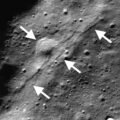70 rogue exoplanets, or planets not bound to a host star, have been discovered wandering through the Milky Way galaxy. Described as a “breakthrough discovery,” the newly identified rogue exoplanets could help researchers better understand how these space bodies develop and ultimately become divorced from their host solar systems.
BACKGROUND: ROGUE EXOPLANETS DIFFICULT TO SPOT
“Unlike planets in our solar system or in exoplanetary systems, rogue planets do not orbit a star but wander alone,” explained Hervé Bouy, an astronomer at the Laboratoire d’Astrophysique de Bordeaux, in a story for Newsweek. “They are special because their properties contain imprints of the mechanisms involved in star and planet genesis that are in many ways much more legible and informative than those of more massive counterparts.”
Unfortunately, rogue planets are incredibly difficult to spot since they are not close to a light-producing star. Now, the team behind the latest discovery have improved rogue exoplanet detection methods, leading to the “breakthrough” discovery.
ANALYSIS: FINDING A GALACTIC NEEDLE IN AN INTERSTELLAR HAYSTACK
“Identifying free-floating planets within a star cluster is a major challenge, in many ways, similar to the ‘needle in the haystack’ adage,” said Bouy. “First, one needs eyes sensitive enough to detect the ‘needles.’ While stars are relatively bright and easy to spot, planetary-mass members are several thousand times fainter and can only be detected with large aperture telescopes and sensitive detectors.”
To accomplish this seemingly impossible task, the team behind the discovery used data gathered over 20 years, and across a wide range of ground and space-based telescopes. They combed through this data looking for tiny motions, luminosities, and even colors before zeroing in on the rogue exoplanets. This meticulous work led to the discovery of 170 such planets, with the announced 70 confirmed thus far.
“We did not know how many [rogue planets] to expect and are excited to have found so many,” said Núria Miret-Roig, astronomer at the Laboratoire d’Astrophysique de Bordeaux and the University of Vienna.
“We have at least doubled the total number of free-floating planets directly detected to date, and this is the largest sample known in a single stellar association, with other examples the spread in the sky,” added Buoy. “We believe the discovery is a breakthrough for both exoplanet and planetary research and star formation studies.”
OUTLOOK: MORE ROGUE EXOPLANET DISCOVERIES INCREASINGLY LIKELY
As for how such planets can form in a solar system before going rogue, the researchers behind the team note there are currently two proposed methods.
“Firstly, that they form like stars, from the collapse of a small molecular clump,” said Buoy. “Secondly, they form as ‘regular’ planets within planetary systems and are later ejected or stripped off from their parent star.”
According to the Newsweek story, the researchers believe that both methods may be true, but the ejection model seems the most likely.
More data will be needed to confirm the other 100 exoplanet candidates, as well as to characterize the size and composition of the 70 exoplanets already confirmed. But the researchers involved in the discovery note that the European Southern Observatory’s Extremely Large Telescope should offer more answers once it is put into operation around 2027.
Follow and connect with author Christopher Plain on Twitter: @plain_fiction
